外研版八年级英语上册 Module 6 Unit 2 教案
外研版英语八年级上册全册教案
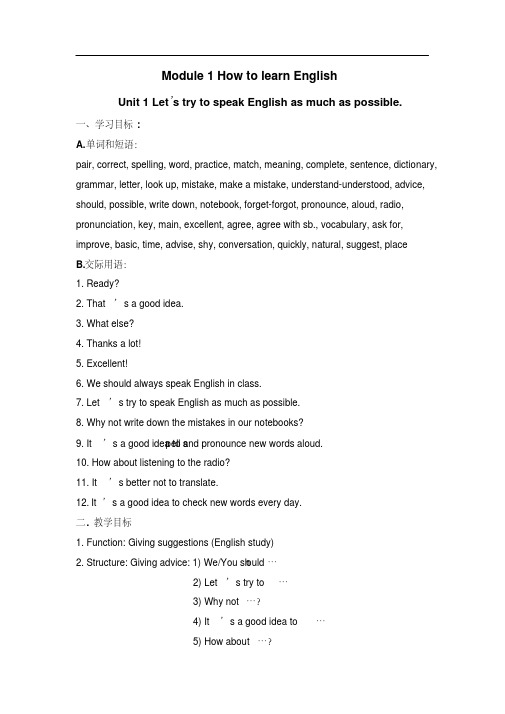
Module 1 How to learn EnglishUnit 1 Let’s try to speak English as much as possible.一、学习目标:A.单词和短语:pair, correct, spelling, word, practice, match, meaning, complete, sentence, dictionary, grammar, letter, look up, mistake, make a mistake, understand-understood, advice, should, possible, write down, notebook, forget-forgot, pronounce, aloud, radio, pronunciation, key, main, excellent, agree, agree with sb., vocabulary, ask for, improve, basic, time, advise, shy, conversation, quickly, natural, suggest, placeB.交际用语:1. Ready?2. That’s a good idea.3. What else?4. Thanks a lot!5. Excellent!6. We should always speak English in class.7. Let’s try to speak English as much as possible.8. Why not write down the mistakes in our notebooks?pell and pronounce new words aloud.9. It’s a good idea to s10. How about listening to the radio?11. It’s better not to translate.12. It’s a good idea to check new words every day.二. 教学目标1. Function: Giving suggestions (English study)2. Structure: Giving advice: 1) We/You sh ould…2) Let’s try to…3) Why not…?4) It’s a good idea to…5) How about…?6) Why don’t we/you…?7) It’s better not to…3. Skills: 1) Listening and understanding familiar topics (English study).2) Talking about problems in English study and giving advice, conductingconversations in several turns.3) Reading and finding specific information about English study.4) Drafting a letter asking for advice about English study, revising throughpair discussion..4. Around the world: English online5. Task: Writing your English study plan.三、重点及难点:Giving advice: 1) We/You should…2) Let’s try to…3) Why not…? 4) It’s a good id to…5) How about…? 6) Why don’t we/you…? 7) It’s better not to…四、教学设计:as much as possible.Unit 1 Let’s try to speak EnglishⅠTeaching modelListening and speakingⅡTeaching methodPWP approachⅢTeaching aims1. To understand conversations involving advice on learning English.2. To get information about how to learn English from the conversation.3. To understand the way of giving advice.4. To practise giving advice on English learning.ⅣTeaching Objectives1. Key vocabulary: pair, correct, spelling, word, practice, match, meaning, complete,sentence, dictionary, grammar, letter, look up, mistake, make amistake, understand-understood, advice, should, possible, writedown, notebook, forget-forgot, pronounce, aloud, radio, key, main,excellent, agree, agree with sb., vocabulary2. Key structures: 1) We/You should…2) Let’s try to…3) Why not…? 4) It’s a go idea to…5) How about…? 6) Why don’t we/you…? 7) It’s better not to…ⅤTeaching aidsTape recorder, OHP , videoⅥTeaching StepsStep 1 Warming up1. Show some pictures of school things. Say how to learn English well.2. Read the words after the teacher.3. Introduce the new words.4. Learn the new words.Step 2 Read and check.1. Read the instructions in Activity 1and check(√) the ones you understand.1) Work in pairs. Ask and answer the questions.2) Correct the spelling.3) Listen and check the words you hear.4) Practise saying the words.5) Match the words with the meaning.6) Complete the sentences with the words in the box.3. Ask the students to check their answer with a partner.4. Call back the answer from the whole class and check the answer.Step 3 Listen and repeat.1. Ask the students to read the word and expressions in Activity2.dictionary grammar letter look up make a mistake meaning understand2. Read through the questions.1) Which word did Daming not understand?2) What mistake did Lingling make?3) How does Daming usually check the spelling of a word?4) Why is it difficult for Daming to check the spelling of cinema?3. Play the recording and ask the students to listen to the recording carefully.4. Listen and answer the questions. Use the words and expressions from the box.5. Play the recording again, then they can check their answer with a partner.6. Call back the answer from the whole class and check the answer.Step 4 Listen and read.1. Show some pictures, and ask the students to talk about them.2. Ask the students to read the conversation silently.3. Play the recording and ask the students to listen and read the conversation.4. Read the conversation.5. Act it out.6. Learn “Everyday English”Ready?That’s a good idea.What else?Thanks a lot!Excellent!7. Tell the students how to learn English well.1) We should always speak English in class.2) Let’s try to speak English as much as possible.3) Why not write down the mistakes in our notebooks?4) Don’t forget to write down the correct answers next to the mistakes.s a good idea to spell and pronounce new words aloud every day.5) It’6) How about listening to the radio?7) How about reading English stories?we try to find some English pen friends?8) Why don’tStep 5 Writing.1. Read the conversation again.2. Ask the students to write notes about learning English.Listening : listen to the radioSpeaking : ___________________________________________________ Reading : ____________________________________________________ Writing: ____________________________________________________Learning new words: ___________________________________________3. Ask the students to check with a partner.4. Check the answers:Keys:Listening : listen to the radioSpeaking : speak English as much as possibleReading : read an English storiesWriting: write to pen friends, write down our mistakes in our notebooks, write down the correct answers next to the mistakesLearning new words: spell and pronounce new words aloud every dayStep 6 Underline the correct words and expressions.1. Ask the students to read through the passage in Activity 4.Here’s my (1) advice / notebook about learning English. Speak English (2) always / as much as possible in class, and listen to English (3) in the newspaper / on the radio. I s a good idea to look up n ew worlds in the ( 5) notebook /(4) agree / forget it’dictionary. You can find the (6) correct / excellent pronunciation and learn the meaning2. Underline the correct words and expressions.3. Check with a partner.4. Call back the answers from the whole class.Keys: 1. advice 2. as much as possible 3. on the radio 4. agree 5. dictionary 6. correct 5. Read the passage together.Step 7 Listen and repeat.1. Play the recording once without stopping.2. Play the recording again and ask the whole class to repeat.1) We should always speak English in class.s try to speak English as much as possible.2) Let’3) Why not write down the mistakes in our notebooks?s a good idea to spell and pronounce new words aloud.4) It’5) How about listening to the radio?3. Ask the students to listen and mark the intonation.4. Now listen again and repeat.Step 8 Work in pairs.1. Talk about problems and give advice.Problems AdviceI can’t… How / What about …?I don’t know… Why not / don’t you …?2. Read through the example with the class.—I can’t speak English well. What should I do?—Why don’t you try to talk to our classmates in English?3. Work in pairs.Step 9 Important and difficult points1 Why not write down our mistakes in our notebooks?何不在笔记本上把我们的错误记下来?Why not …? 用来表示提出某种建议,而不是询问为什么不做某事的原因,例如:Why not take a walk in the park ?何不在公园里散散步?我们还可以用下面的表达方式来提建议:Why don’t we drive to the country?我们何不开车去乡下?What / How about going to Europe for a holiday?去欧洲度假怎么样?Write down 或者put down 表示“记下,写下”。
外研版八上英语教案

外研版八上英语教案【篇一:新外研版八年级英语上册1-12模块教案】 module 1 how to learn englishunit 1 let’s try to speak english as much as possible.第1、2课时【学习目标】1、(知识与技能):掌握下列重点单词的意思及用法:translate, correct, match number, advice,mistake, message, each, spelling,pronunciation, newspaper, excellent.掌握下列短语的意思及用法:give sb. some advice, write it/them down, speak english, in class, do some concerts, try (not) to do sth., each other, help sb. with sth.2、(过程与方法):通过本节的学习,培养学生的探究精神和创新意识,提高学生解决实际问题的能力。
3、(情感、态度与价值观)掌握学习英语的方法,提高学习英语的兴趣,懂得与人交流,注意语言的得体性。
【重点难点】1.重点句式:how about listening to the radio and reading a newspaper in english?try not to translate every word.you should always speak english in class.why don‘t you write down your mistakes?2.难点:提建议的常用表达方法。
【学法指导】课前在熟读单词与短文的基础上认真完成自主学习内容并能把重点单词短语熟记于心,完成探究内容,对未能解答的问题做上标记,课堂上,跟着老师的指导,完成听读训练,学习新的语法知识,并纠正自己在课前完成的任务。
第二课时外研版英语八年级上册Module6Unit2教学设计

(二)讲授新知,500字
在导入新课之后,我将系统地讲授以下新知识:
1.词汇教学:通过PPT展示新词汇,如“concern”, “decrease”, “waste”, “reuse”, “recycle”等,并配以例句和图片,帮助学生理解和记忆。
四、教学内容与过程
(一)导入新课,500字
在本节课开始时,我将通过以下方式导入新课:
1.展示图片:呈现一系列与环保相关的图片,如污染的河流、垃圾分类等,引导学生观察并思考这些图片所传达的信息。
2.视频引入:播放一段关于环保的宣传视频,让学生了解环保的重要性,激发他们的学习兴趣。
3.问题引导:提出问题,如“Do you think it's important to protect the environment?”和“What can we do to save energy and reduce waste?”让学生思考并展开简短讨论。
4.自主学习法:鼓励学生在课后进行自主学习,通过查阅资料、观看视频等途径,拓宽知识面。
(三)情感态度与价值观
在本章节的学习过程中,学生将形成以下情感态度与价值观:
1.意识到环保的重要性,树立环保意识,自觉承担起保护环境的责任。
2.关注社会问题,关心人类生存环境,培养关爱自然、关爱他人的情感。
3.增强团队合作意识,学会倾听他人意见,尊重不同观点。
1.词汇巩固:请学生将本节课学习的新词汇整理成词汇表,并尝试用这些词汇造句,加深对词汇意义的理解。
-提示:可以结合日常生活中的环保行为,如“Reducing paper usage at school is an effective way to save trees.”
外研版八年级上册Module 6教案及练习

外研版八年级上册Module 6Animals in danger Unit 1 It allows people to get closer to them【第一学时】【学习目标】1.掌握新单词以及表达。
2.提高听和说的能力。
3.了解面临灭绝的动物有哪些。
【学习过程】I. Listening.1.What is this week’s Animal World about?A pandasB snakesC lions2.Animals such as pandas, elephants and are in danger.1.Where did Ling and Betty go?A.Panda Reserve B.the zoo C.the museum2.What kind of animal did Betty see at last?A PandasB tigersC monkeys3.Do many animals have a safe place to live?A.Yes, they do. B No, they don’t.4.Is there enough clean water?A.Y es, there is. B.No, there isn’t.5.We can give ______ to help protect the animals.A. Water B. money C. forestⅡ. Reading: Read and answer the questions.1.Why did Betty like the panda in the Panda Reserve?A.B ecause it was interestingB.B ecause the pandas there are in dangerC.B ecause it allows people to get closer to them.2.It is sad to pandas and other animals3.Many animals are in danger because______.A.They have no safe place to live. B.There isn’t enough clean water.B.Both A and B.4.What will they do to protect animals next?Ⅲ.Use the correct form of the words and expressions to complete the passage.I went to the zoo yesterday. I saw many animals, and I saw the pandas. But I hope to see pandas in the Panda Reserve, because it ____People get closer to them. It is pity that many animals, such as panda, are . Because villages and farms are their lands and forests, and they don’t have a safe place to live. Besides, there isn’t clean water. I think we need to help animals live . So I plan to at school to save these animals. 【学习拓展】一、从方框中选择适当的选项,完成对话。
外研版英语八年级上Module6Unit2教案
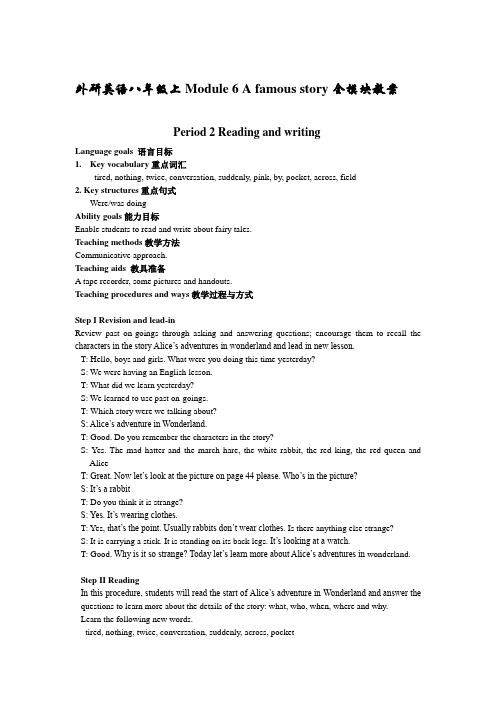
外研英语八年级上Module 6 A famous story全模块教案Period 2 Reading and writingLanguage goals 语言目标1.Key vocabulary重点词汇tired, nothing, twice, conversation, suddenly, pink, by, pocket, across, field2. Key structures重点句式Were/was doingAbility goals能力目标Enable students to read and write about fairy tales.Teaching methods教学方法Communicative approach.Teaching aids 教具准备A tape recorder, some pictures and handouts.Teaching procedures and ways教学过程与方式Step I Revision and lead-inReview past on-goings through asking and answering questions; encourage them to recall the characters in the story Alice’s adventures in wonderland and lead in new lesson.T: Hello, boys and girls. What were you doing this time yesterday?S: We were having an English lesson.T: What did we learn yesterday?S: We learned to use past on-goings.T: Which story were we talking about?S: Alice’s adventure in Wonderland.T: Good. Do you remember the characters in the story?S: Yes. The mad hatter and the march hare, the white rabbit, the red king, the red queen and AliceT: Great. Now let’s look at the picture on page 44 please. Who’s in the picture?S: It’s a rabbitT: Do you think it is strange?S: Yes. It’s wearing clothes.T: Yes, t hat’s the point. Usually rabbits don’t wear clothes. Is there anything else strange?S: It is carrying a stick. It is standing on its back legs. It’s looking at a watch.T: Good. Why is it so strange? Today let’s learn more about Alice’s adventures in wonderland.Step II ReadingIn this procedure, students will read the start of Alice’s adventure in Wonderland and answer the questions to learn more about the details of the story: what, who, when, where and why.Learn the following new words.tired, nothing, twice, conversation, suddenly, across, pocketAnd then ask students to read individually and discuss the questions with a partner.Check the answers. Ask them to read again and decide whether the following sentences are true or false.1.Alice was reading a book.2.The book had a lot of pictures in it.3.Alice wanted to make daisy chain.4. A white rabbit ran past Alice and her sister.5.The rabbit was wearing clothes.6.The rabbit went into a hole under a big tree.7.Alice entered the hole after the rabbit.Check the answers.Step III WritingIn this step, students will do the match work first to know something about Lewis Carroll. Introduce more about Lewis Carroll to them and then ask them to write the story of Lewis Carroll and Alice LiddellT: Last period, I asked you to find some information about the writer of the story, have you finished?S: Yes.T: Can you tell me who the writer is?S: Lewis Carroll.T: Good. Today let’s learn more about the writer. Let’s learn why and how he wrote this story? Ask students to read the questions and answers fast, make sure they understand each one, and then let them do the match work.After a few minutes, call back the answers from the whole class, having one student ask a question and another answer. Explain when necessary.If possible, introduce more about the writer. (See Teaching resources: I)Then ask students to make a list of the information of Lewis Carroll and Alice Liddell and then join the sentences with “one day…, then…, and finally…”to write the story.When they have finished, ask some of them to read their story to the class.Sample version:Lewis Carroll’s real name was Charles Dodgson. He was tea ching math at the University of Oxford, England. One day he saw Alice in a garden. She was playing with her sisters. Carroll went to meet the girls and they asked him to take their photos. He became good friends with the Liddell children. One day they were having a picnic by the river, and Carroll was telling the girls lots of stories. Alice asked him to wri te down the stories. Then Carroll wrote Alice’s Adventures in Wonderland. Finally Alice’s Adventures with Lewis Carroll ended when she grew up.When they have finished, ask some of them to read their story to the class.Step IV HomeworkAsk students to1.make sentences with the phrases: Once or twice, look into, what…for…, b e doing…when…,think of, grow up, have a picnic.2.do activities 5-6 in the workbook.。
外研版英语八年级上册单元教案-Module2
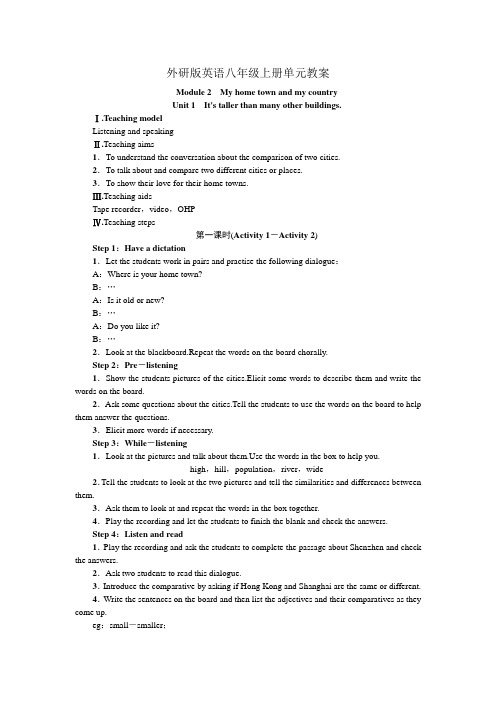
外研版英语八年级上册单元教案Module 2My home town and my countryUnit 1It's taller than many other buildings.Ⅰ.Teaching modelListening and speakingⅡ.Teaching aims1.To understand the conversation about the comparison of two cities.2.To talk about and compare two different cities or places.3.To show their love for their home towns.Ⅲ.Teaching aidsTape recorder,video,OHPⅣ.Teaching steps第一课时(Activity 1-Activity 2)Step 1:Have a dictation1.Let the students work in pairs and practise the following dialogue:A:Where is your home town?B:…A:Is it old or new?B:…A:Do you like it?B:…2.Look at the blackboard.Repeat the words on the board chorally.Step 2:Pre-listening1.Show the students pictures of the cities.Elicit some words to describe them and write the words on the board.2.Ask some questions about the cities.Tell the students to use the words on the board to help them answer the questions.3.Elicit more words if necessary.Step 3:While-listening1.Look at the pictures and talk about e the words in the box to help you.high,hill,population,river,wide2.Tell the students to look at the two pictures and tell the similarities and differences between them.3.Ask them to look at and repeat the words in the box together.4.Play the recording and let the students to finish the blank and check the answers.Step 4:Listen and read1.Play the recording and ask the students to complete the passage about Shenzhen and check the answers.2.Ask two students to read this dialogue.3.Introduce the comparative by asking if Hong Kong and Shanghai are the same or different.4.Write the sentences on the board and then list the adjectives and their comparatives as they come up.eg:small-smaller;quiet-quieter;old-older…5.Ask the students to look at the spelling of the comparatives and summarize how comparative adjectives are formed.6.Play the recording again and let the students follow the tape to read the passage aloud.Step 5:Everyday EnglishHey!How was your weekend?Pretty good!Step 6:Homework1.Learn the new words by heart.2.Act out the conversation in groups.3.Finish off the workbook exercises.Blackboard DesignUnit 1It's taller than many other buildings.small-smallerquiet-quieterold-oldernew-newerbusy-busierbig-biggerwide-wider第二课时(Activity 3-Activity 6)Step 1:Have a dictationGet the students to write the words and phrases in Unit 1,then check the answers to see if they have grasped the usages of the points.Step 2:Practice1.Read the conversation in Activity 2 again.2.Answer the following questions.(1)How was Daming's weekend?(2)Where is Shenzhen?(3)What's the population of Shenzhen?(4)Is Shenzhen newer than Hong Kong?(5)Does Tony want to go to Shenzhen one day?3.Read the words and expressions in the box in Activity 3.4.Ask the students to complete the sentences with the correct form of the words in the box individually.Remind them to be careful of the spelling.5.Check the answers.6.Tell the students to read the sentences and think about which word should be chosen for each sentence,whether the word should be changed and how.Step 3:Pronunciation1.Listen and notice how the speaker stresses the underlined words.(1)Ask the students to read through the four conversations on their own.(2)Play the recording.Ask the students to pay attention to the underlined words and thinkabout why they are underlined.(3)Elicit that the underlined words are stressed to correct wrong information.(4)Play the recording again and have the students repeat the conversations chorally and individually.Tell them to pay attention to the underlined words and exaggerate the stressed syllables for the meaning.(5)Put the students in pairs to practise the conversations.Tell them to stress the underlined words and practise with his/her partner.Step 4:Speaking1.Ask the students to compare Shenzhen with their home town.Make notes in the table.2.Ask the students to fill in the table with information about Shenzhen and their home town,with notes to describe sizes,population,ways of life,etc.3.Work in pairs.Talk about the differences between Shenzhen and their home town.(Use big,small,hot,cold,tall or new).—Is your home town bigger than Shenzhen?—No,it isn't.It's smaller than Shenzhen.Step 5:Homework1.Revise all the check points in this unit.2.Finish off the workbook exercises.Blackboard DesignUnit 1It's taller than many other buildings.So it's a newer city than Hong Kong?…it will become as busy as Hong Kong.What's the population of Shenzhen?Its streets are much wider and cleaner too.It's taller than many other buildings.Unit 2Cambridge is a beautiful city in the east of England.Ⅰ.Teaching modelReading and WritingⅡ.Teaching aims1.To describe the location of a place.To get information about Cambridge,London and English.2.To write something about their home town.3.To know about western country—England.Ⅲ.Teaching aidsTape recorder,video,OHPⅣ.Teaching steps第一课时(Activity 1-Activity 2)Step 1:Have a dictationTeach the words and expressions.1.Look at the map of England and read the sentences.Cambridge is in the east of England.London is in the south of England.Bristol is in the west of England.Manchester is in the north of England.2.Ask the students to look at the map and tell what it shows.3.Read out the sentences while they follow.Step 2:Pre-reading1.Show some pictures of Cambridge,London and England.2.Introduce them to the students.Step 3:Reading1.Read the passage and choose a title for each picture below.(1)Ask the students to look at the pictures and elicit what they can see.(2)Ask them to guess which places the pictures show and predict the title for each picture.(3)Ask them to read the passage and check whether their guesses and predictions are right.(4)Ask them to choose the correct titles and check the answers with their partners.2.Ask the students to read it again and underline all the points which are important with their partners.3.Show the key points to the class,and explain some difficulties to the students.4.Let them work in pairs to act out the conversation.Step 4:Homework1.Read the words and the passage frequently.2.Copy the words and expressions.3.Finish some exercises in workbook.Blackboard DesignUnit 2Cambridge is a beautiful city in the east of England.in the east/west/north/south ofhave/has a population ofbe famous forbe part ofbring an umbrellaby boat第二课时(Activity 3-Activity 7)Step 1:ReviewAsk and answer about the passage in Activity 2:1.Where does Tony Smith come from?2.What's the population of Cambridge?3.Where is London?4.What's the weather like in England?Step 2:Have a dictationGet the students to write the words and phrases in Unit 2,then check the answers to see if they have grasped the usages of the points.Step 3:Practice1.Have a reading competition.Let several students read the passage in Activity 2 and see who reads best.2.After reading the passage in Activity 2,complete the table comparing Cambridge with London.(1)Ask the students to look at the table to see what information they have to find.(2)Tell them to scan the passage quickly to find the key information and underline it.(3)Ask them to complete the table on their own.(4)Ask them to check answers with their partners.(5)Elicit answers in full sentences from the whole class.3.Complete the passage with the words and expression in the box.(1)Read through the words and expression in the box with the class.Make sure they are clear about the meanings.(2)Ask the students to read the passage.Make clear what it is about.(3)Tell them to read the passage again and complete it.(4)Elicit answers from the whole class.Step 4:Writing1.Answer the questions and write notes about their home town.(1)Tell them to exchange their notes with their partners and work together to correct factual and language mistakes.(2)Elicit answers and check with the class to see if they are correct.2.Use their notes and write answers to the questions in Activity 5.Dalian is in the northeast of China.It has a population of over six million.Collect a few examples from the class.Present them.3.Write a passage called My home e Tony's passage to help them.They may begin like this:I come from Dalian,a beautiful city in the northeast of China.It has a population of over six million.It is…4.Share their passages with others.Step 5:Homework1.Revise all the key points in this unit.2.Finish the writing.3.Finish the workbook.Blackboard DesignUnit 2Cambridge is a beautiful city in the east of England.Key vocabulary:north,south,west,home town,be famous for,island,area,low,mountain,countryside,umbrellaKey structure:It has a population of about 120,000.…so it is bigger and busier than Cambridge.It is never very hot in summer or very cold in winter.Unit 3Language in useⅠ.Teaching modelRevision and applicationⅡ.Teaching aims1.To summarize and consolidate the use of comparative adjectives (-er).2.To compare two places in their home town.3.To show their love for their country and hometown in English.Ⅲ.Teaching aidsTape recorder,video,OHPⅣ.Teaching steps第一课时(Activity 1-Activity 5)Step 1:Warming up1.Write the adjectives in the grammar box on the board:It's getting bigger and busier.Its streets are much wider and cleaner too.It's a newer city than Hong Kong.It's taller than many other buildings in Shenzhen.big,busy,new,wide,clean,tall.2.Remind the students of how to make comparatives.3.Elicit the comparatives of the words and write them under the adjectives on the board:bigger,busier,newer,wider,cleaner,taller.Step 2:Practice 11.Complete the sentences with the correct form of the words in the box.(1)Review the rules for the spelling of comparatives with the students.(2)Read the words aloud,and pay attention to the pronunciation.2.Work in pairs.Talk about the e the words in the box.(1)Ask the students to work in pairs and describe the pictures.For example:The buildings in Picture 1 are older than the buildings in Picture 2.…(2)Check answers with their partners.3.Write e the information in the table.(1)Go through the words in the box.(2)Look at the two pictures and elicit some descriptions around the class.(3)Look at the information,read the example,and write sentences.Encourage them to share their sentences in class.For example:Shenzhen is newer than Beijing.…Step 3:Practice 21.Complete the word map with the words in the e one word more than once.(1)Read the words in the box,and complete the map with them.(2)Use the information on the map to make sentences.2.Complete the sentences with the expressions in the box.(1)Read the expressions in the box first.(2)Complete the sentences.(3)Read out the sentences,and check the answers.3.Complete the passage with the correct form of the words in brackets.4.Let the students read the passage and check the answers.Step 4:Homework1.Revise all the key points in this module.2.Finish the workbook.Blackboard DesignUnit 3Language in useKey vocabulary:big,busy,new,wide,clean,tallbigger,busier,newer,wider,cleaner,tallerKey structure:Shenzhen is newer than Beijing.The buildings in Picture 1 are older than the buildings in Picture 2.第二课时(Activity 6-Activity 11)Step 1:Pre-listening1.Ask the students to look at the pictures and ask them if they recognize the cities and know the names of the buildings shown.2.Pronounce the names of the cities correctly and understand their meanings.Step 2:Listening1.Play the recording and have the students listen to the conversation and complete the sentences.2.Play the recording again for the students to check the answers.3.Let them read the sentences aloud.Step 3:Around the worldWashington DC1.Introduce some key words and phrases in the passage to students.2.Get the students to read this passage.3.Then ask a few students to read it,and translate it into Chinese at last.4.Solve the problems that the students meet while reading.Step 4:WritingMaking a report comparing two places in your home town.1.Work in pare two places in your home town.(1)Students decide which places they want to research.Where is it?It is in the north/south/east/west of the town.How many people work/go there?…people work/go there.How old is it?It's about…years old.Is there anything special about it?It's bigger than…2.Fill in the table with the information from the list.Add the information to the list.3.Make a report like this:Place 1 is bigger than Place 2.Place 2 is older than Place 1.Join the sentences using and or but.Place 1 is bigger than Place 2,but Place 2 is older than Place 1.4.Read the report to the whole class.Step 5:Homework1.Finish the workbook in this module.2.Revise the whole module.Blackboard DesignUnit 3Language in use the capital ofon the east coastbe best known formillions ofshow…to…send…to…human—humans。
外研版八年级英语上册Module 6 unit 2课例分析

初中英语八年级上(外研版)Module 6 unit 2课例分析本课是我于10月27日下午第六节课带领着八年四班的学生们在课改大课堂上实授的。
这节课型为外研版教科书英语八年级上册第六模块第二单元的阅读课,课文承接了第一单元对话中提到的Alice adventures in wonderland和a famous story的话题,主要讲述了爱丽丝梦游仙境开头部分的故事,这是学生比较喜欢的童话故事,利用这种题材的文章进行教学有助于激发学生的参与意识和学习动机。
故事是教授过去进行时比较适合的题材,即可学习语法,又可培养叙述能力。
本课本模块以童话故事为主题,通过对故事内容的叙述,介绍过去进行时的结构和用法,使学生在无意识的情况下学习,掌握语法,真正做到了语法与故事相结合。
一、对于教学内容的分析与反思本模块以童话故事为主题,把语法与故事结合起来,采用隐性教育的方式让学生在了解故事的同时掌握过去进行时的结构和用法。
Unit 2通过讨论图片导入故事,以激发学生兴趣,并熟悉相关词汇,为阅读提供词汇、句法及背景知识的准备(1)。
2是节选自Alice’s Adventures in Wonderland的一段小故事,要求学生读后回答问题。
3要求将问句和答语进行匹配,通过问答匹配了解故事的创作背景,为活动4的写作任务做准备。
这一活动训练的是阅读理解能力,可帮助学生更好地理解课文。
4是写作活动。
要求根据活动3中内容写一则关于Lewis Carroll and Alice Liddell的小故事。
本活动不仅仅训练过去进行时的用法,还要求掌握叙述故事的时间顺序以及时间衔接词的用法,如:One day … Then … and Finally。
教师的重点应该放在故事叙述过程中的相关的词汇及词组的运用掌握以及如何运用过去进行时进行事件故事的描述上。
二、对教学过程和效果的反思本课以素质教育为目的,结合教材重点、难点及英语学科的特点,利用多媒体辅助教学,使学生听、说、读、写的能力得到全面提高。
外研版八年级英语上册教案 M6U2-1

Zoos and research centers protect animals. (1) _________ do a lot of research to help pandas (2) _______ more babies. Very few (3) _______ pandas are born outside zoos. Many people are worried about the panda’s (4) ________. Luckily, the (5) ___________ is developing plans to (6) ______ pandas, and is setting up (7) ______ parks to protect them.
能找出对应词汇并写出正确形式
Step 3
After-reading
1.Retell the passage according to the given information.
Situation
Solution(措施)
Number:1600+340
Baby: not many,
often die
Home:forests and mountains
In a word:Animals are our friends.We should protect them! To help animals is to help ourselves.
能根据表格复述课文内容
外研版八年级英语上册全册教案(教学设计)
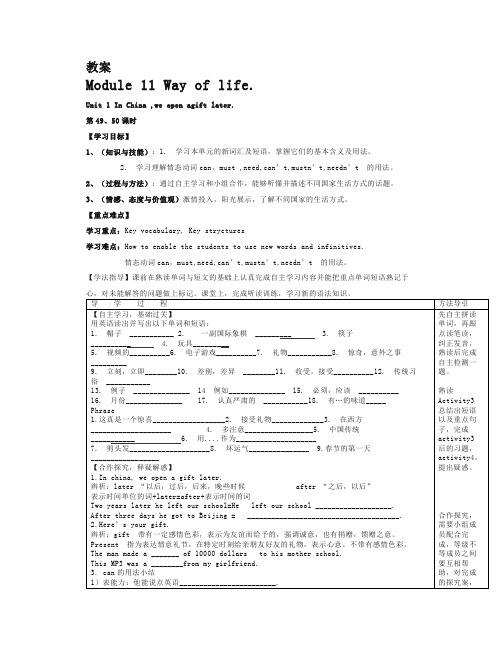
教案Module 11 Way of life.Unit 1 In China ,we open agift later.第49、50课时【学习目标】1、(知识与技能):1. 学习本单元的新词汇及短语,掌握它们的基本含义及用法。
2. 学习理解情态动词can,must ,need,can’t,mustn’t,needn’t的用法。
2、(过程与方法):通过自主学习和小组合作,能够听懂并描述不同国家生活方式的话题。
3、(情感、态度与价值观)激情投入,阳光展示,了解不同国家的生活方式。
【重点难点】学习重点:Key vocabulary, Key stryctures学习难点:How to enable the students to use new words and infinitives.情态动词can,must,need,c an’t,mustn’t,needn’t的用法。
【学法指导】课前在熟读单词与短文的基础上认真完成自主学习内容并能把重点单词短语熟记于Module 11 Way of life.Unit2 In England, you usuallydrink tea with milk.第51、52课时【学习目标】1、(知识与技能):掌握本单元的重点词汇短语、句型。
2、(过程与方法):通过阅读文章及小组合作,学会理解文章大意和提取细节信息的方法。
3、(情感、态度与价值观)能了解一些英国的传统习俗,在短文中获取有效信息。
让学生了解不同的国家有不同的传统习惯,要尊重文化差异。
【重点难点】学习重点:Key vocabulary, Key stryctures学习难点:How to enable the students to use new words and infinitives.情态动词can,must,need,can’t,mustn’t,needn’t的用法。
【学法指导】课前在熟读单词与短文的基础上认真完成自主学习内容并能把重点单词短语熟记于Module 11 Way of life.Unit 3 Language in use.第53课时【学习目标】1、记住M11的单词和短语,并归纳can , can’t , must , mustn’t , needn’t的用法。
外研版英语(新标准)八年级上册教案(全册)(完美版)
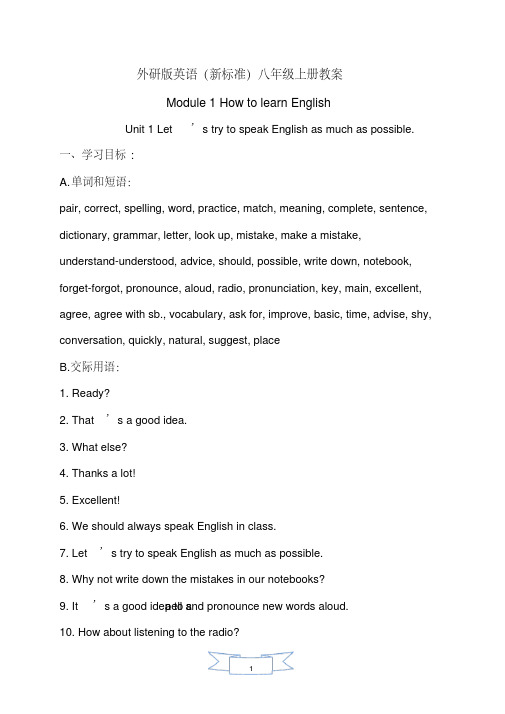
外研版英语(新标准)八年级上册教案Module 1 How to learn EnglishUnit 1 Let’s try to speak English as much as possible.一、学习目标:A.单词和短语:pair, correct, spelling, word, practice, match, meaning, complete, sentence, dictionary, grammar, letter, look up, mistake, make a mistake,understand-understood, advice, should, possible, write down, notebook, forget-forgot, pronounce, aloud, radio, pronunciation, key, main, excellent, agree, agree with sb., vocabulary, ask for, improve, basic, time, advise, shy, conversation, quickly, natural, suggest, placeB.交际用语:1. Ready?2. That’s a good idea.3. What else?4. Thanks a lot!5. Excellent!6. We should always speak English in class.7. Let’s try to speak English as much as possible.8. Why not write down the mistakes in our notebooks?pell and pronounce new words aloud.9. It’s a good idea to s10. How about listening to the radio?11. It’s better not to translate.12. It’s a good idea to check new words every day.二. 教学目标1. Function: Giving suggestions (English study)2. Structure: Giving advice: 1) We/You sh ould…2) Let’s try to…3) Why not…?4) It’s a good idea to…5) How about…?6) Why don’t we/you…?7) It’s better not to…3. Skills: 1) Listening and understanding familiar topics (English study).2) Talking about problems in English study and giving advice,conductingconversations in several turns.3) Reading and finding specific information about English study.4) Drafting a letter asking for advice about English study, revisingthrough pair discussion..4. Around the world: English online5. Task: Writing your English study plan.三、重点及难点:Giving advice: 1) We/You should…2) Let’s try to…3) Why not…? 4) Itgood idea to…5) How about…? 6) Why don’t we/you…? 7) It’s better no 四、教学设计:Unit 1 Let’s try to speak English as much as possible.ⅠTeaching modelListening and speakingⅡTeaching methodPWP approachⅢTeaching aims1. To understand conversations involving advice on learning English.2. To get information about how to learn English from the conversation.3. To understand the way of giving advice.4. To practise giving advice on English learning.ⅣTeaching Objectives1. Key vocabulary: pair, correct, spelling, word, practice, match, meaning,complete, sentence, dictionary, grammar, letter, look up,mistake, make a mistake, understand-understood, advice,should, possible, write down, notebook, forget-forgot,pronounce, aloud, radio, key, main, excellent, agree, agreewith sb., vocabulary2. Key structures: 1) We/You should…2) Let’s try to…3) Why not…? 4 good idea to…5) How about…? 6) Why don’t we/you…? 7) It’s better no ⅤTeaching aidsTape recorder, OHP , videoⅥTeaching StepsStep 1 Warming up1. Show some pictures of school things. Say how to learn English well.2. Read the words after the teacher.3. Introduce the new words.4. Learn the new words.Step 2 Read and check.1. Read the instructions in Activity 1and check(√) the ones you understand.1) Work in pairs. Ask and answer the questions.2) Correct the spelling.3) Listen and check the words you hear.4) Practise saying the words.5) Match the words with the meaning.6) Complete the sentences with the words in the box.3. Ask the students to check their answer with a partner.4. Call back the answer from the whole class and check the answer.Step 3 Listen and repeat.1. Ask the students to read the word and expressions in Activity2. dictionary grammar letter look up make a mistake meaning understand2. Read through the questions.1) Which word did Daming not understand?2) What mistake did Lingling make?3) How does Daming usually check the spelling of a word?4) Why is it difficult for Daming to check the spelling of cinema?3. Play the recording and ask the students to listen to the recording carefully.4. Listen and answer the questions. Use the words and expressions from the box.5. Play the recording again, then they can check their answer with a partner.6. Call back the answer from the whole class and check the answer.Step 4 Listen and read.1. Show some pictures, and ask the students to talk about them.2. Ask the students to read the conversation silently.3. Play the recording and ask the students to listen and read the conversation.4. Read the conversation.5. Act it out.6. Learn “Everyday English”Ready?That’s a good idea.What else?Thanks a lot!Excellent!7. Tell the students how to learn English well.1) We should always speak English in class.2) Let’stry to speak English as much as possible.3) Why not write down the mistakes in our notebooks?4) Don’t forget to write down the correct answers next to the mistakes.spell and pronounce new words aloud every day.5) It’s a good idea to6) How about listening to the radio?7) How about reading English stories?we try to find some English pen friends?8) Why don’tStep 5 Writing.1. Read the conversation again.2. Ask the students to write notes about learning English.Listening : listen to the radioSpeaking : ___________________________________________________ Reading : ____________________________________________________ Writing: ____________________________________________________ Learning new words: ___________________________________________3. Ask the students to check with a partner.4. Check the answers:Keys:Listening : listen to the radioSpeaking : speak English as much as possibleReading : read an English storiesWriting: write to pen friends, write down our mistakes in our notebooks, writedown the correct answers next to the mistakesLearning new words: spell and pronounce new words aloud every dayStep 6 Underline the correct words and expressions.1. Ask the students to read through the passage in Activity 4.Here’s my (1) advice / notebook about learning English. Speak English (2) always / as much as possible in class, and listen to English (3) in the newspaperew worlds in the/ on the radio. I (4) agree / forget it’s a good idea to look up n ( 5) notebook / dictionary. You can find the (6) correct / excellent pronunciation and learn the meaning2. Underline the correct words and expressions.3. Check with a partner.4. Call back the answers from the whole class.Keys: 1. advice 2. as much as possible 3. on the radio 4. agree 5. dictionary 6. correct 5. Read the passage together.Step 7 Listen and repeat.1. Play the recording once without stopping.2. Play the recording again and ask the whole class to repeat.1) We should always speak English in class.2) Let’s try to speak English as much as possible.3) Why not write down the mistakes in our notebooks?4) It’s a good idea to spell and pronounce new words aloud.5) How about listening to the radio?3. Ask the students to listen and mark the intonation.4. Now listen again and repeat.Step 8 Work in pairs.1. Talk about problems and give advice.Problems AdviceI can’t… How / What about …?I don’t know… Why not / don’t you …?2. Read through the example with the class.—I can’t speak English well. What should I do??—Why don’t you try to talk to our classmates in English3. Work in pairs.Step 9 Important and difficult points1 Why not write down our mistakes in our notebooks?何不在笔记本上把我们的错误记下来?Why not …? 用来表示提出某种建议,而不是询问为什么不做某事的原因,例如:Why not take a walk in the park ?何不在公园里散散步?我们还可以用下面的表达方式来提建议:Why don’t we drive to the country?我们何不开车去乡下?What / How about going to Europe for a holiday?去欧洲度假怎么样?Write down 或者put down 表示“记下,写下”。
外研版八年级英语下册 module6 unit2教案 (1)
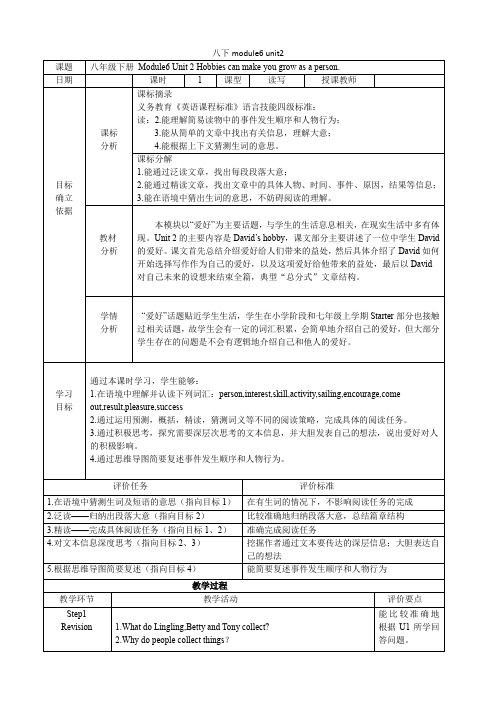
4.能在教师的帮助下或以小组讨论的方式起草和修改作文。
课标分解 1.能通过变式朗读,连贯流畅地朗读课文; 2.能通过两人对话,就“hobby” 这一话题进行交谈; 3.能运用所学语言点的和文章结构,仿写作文。
张蕊
教材 分析
本模块以“爱好”为主要话题,与学生的生活息息相关,在现实生活中多有体 现。Unit 2 的主要内容是 David’s hobby,课文部分主要讲述了一位中学生 David 的爱好。课文首先总结介绍爱好给人们带来的益处,然后具体介绍了 David 如何 开始选择写作作为自己的爱好,以及这项爱好给他带来的益处,最后以 David 对自己未来的设想来结束全篇,典型“总分式”的文章结构。
能大胆发表自 己的观点。
In 2010
He spent four weeks at a ____.There was a writing class.
His teacher______ him to write about their experiences at the camp.
Step6
Back at school
hard work
experience future plan
Step10
How to develop our hobbies?
Show a video
Homework
1. Read aloud the new words and phrases. 2. Read aloud the passage. 3. Share your hobbies with your classmates.
学情 分析
“爱好”话题贴近学生生活,学生在小学阶段和七年级上学期 Starter 部分也 接触过相关话题,故学生会有一定的词汇积累,会简单地介绍自己的爱好,但 部分学生存在的问题是不会有逻辑地介绍自己和他人的爱好。
外研版英语八年级上册Module 6《Animals in danger》(Unit 2)教学设计
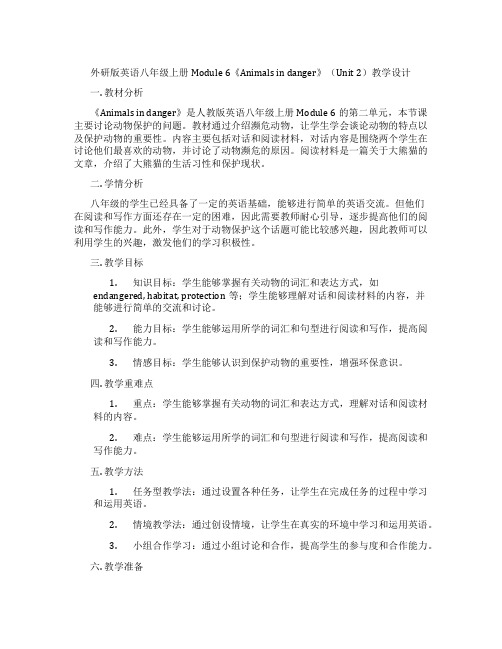
外研版英语八年级上册Module 6《Animals in danger》(Unit 2)教学设计一. 教材分析《Animals in danger》是人教版英语八年级上册Module 6的第二单元,本节课主要讨论动物保护的问题。
教材通过介绍濒危动物,让学生学会谈论动物的特点以及保护动物的重要性。
内容主要包括对话和阅读材料,对话内容是围绕两个学生在讨论他们最喜欢的动物,并讨论了动物濒危的原因。
阅读材料是一篇关于大熊猫的文章,介绍了大熊猫的生活习性和保护现状。
二. 学情分析八年级的学生已经具备了一定的英语基础,能够进行简单的英语交流。
但他们在阅读和写作方面还存在一定的困难,因此需要教师耐心引导,逐步提高他们的阅读和写作能力。
此外,学生对于动物保护这个话题可能比较感兴趣,因此教师可以利用学生的兴趣,激发他们的学习积极性。
三. 教学目标1.知识目标:学生能够掌握有关动物的词汇和表达方式,如endangered, habitat, protection等;学生能够理解对话和阅读材料的内容,并能够进行简单的交流和讨论。
2.能力目标:学生能够运用所学的词汇和句型进行阅读和写作,提高阅读和写作能力。
3.情感目标:学生能够认识到保护动物的重要性,增强环保意识。
四. 教学重难点1.重点:学生能够掌握有关动物的词汇和表达方式,理解对话和阅读材料的内容。
2.难点:学生能够运用所学的词汇和句型进行阅读和写作,提高阅读和写作能力。
五. 教学方法1.任务型教学法:通过设置各种任务,让学生在完成任务的过程中学习和运用英语。
2.情境教学法:通过创设情境,让学生在真实的环境中学习和运用英语。
3.小组合作学习:通过小组讨论和合作,提高学生的参与度和合作能力。
六. 教学准备1.教师准备教材、教案、课件等教学材料。
2.学生准备课本、笔记本等学习用品。
七. 教学过程1.导入(5分钟)教师通过向学生展示一些濒危动物的图片,引导学生谈论动物保护的话题。
外研版八年级英语上册课件 Module 6 A famous story
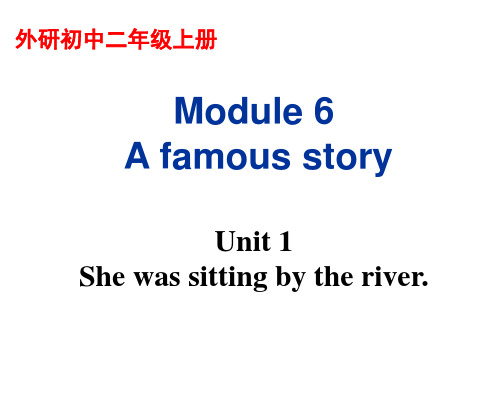
Now listen again and check.
Listen and answer:
1. Why was the rabbit running in the story?
2. Where was the rabbit going?
Find words and expressions in the box for.
Look at the following picture and tell us the story.
Alice’s Adventures in Wonderland
One day Alice was sitting by the river with a book, but she wasn’t reading it. Suddenly a white rabbit ran past her. It was looking at its watch. Because it was going to a tea party. Then Alice fell down a rabbit hole and went into their strange world.
Look for was /were doing sentences in the passage.
1. Alice was getting very tired.
2. She was sitting with her sister by the river and her sister was reading a book.
Listen and write notes about what the people in Activity 2 were doing.
the Mad Hatter and the March Hare
Module 6 Unit 2 示范课教学设计(外研版九年级英语上册)

Module 6 ProblemsUnit 2 If you tell him the truth now, you will show that you are honest.教学设计一、教学目标1. 掌握以下词汇:come round, reason, try out, angry, no longer, be angry with sb., repair, truth, least, at least, honest, apologise2. 正确运用以下句型:The reason is that he thinks something will go wrong if I play games on it.If you tell him the truth now, he will be angry with you, but at least you will show that you are honest.3. 能够理解句型结构相似的复合句之间的差异,通过对比优化学习。
4. 能够读懂描述生活问题和给建议的书信并提取相关信息。
5. 能够运用所学的知识写出自己遇到的问题并寻求解决问题的建议。
6. 通过学习,提示学生在遇到了问题和烦恼时,要积极寻找解决问题的途径,而不是采取非理智的极端行为。
二、教学重点及难点重点:1. 能够运用所掌握的语法、句型和词汇进行交际。
2. 能够运用语言和语法知识进行阅读并理解文章的意思。
难点:能够运用所学的知识写出自己遇到的问题并寻求建议。
三、教学准备多媒体课件四、相关资源五、教学过程Step I Warm-up1. Brainstorming ---What will you do if...?If I have time, I’ll _____________.If I get up late, I’ll_____________.If it rains today, I’ll ____________.If it’s sunny today, I’ll__________.设计意图:通过头脑风暴活动,可以让学生在轻松的氛围中复习上节课话题。
Module 6 Unit2 第二课时学历案--外研版英语八年级下册
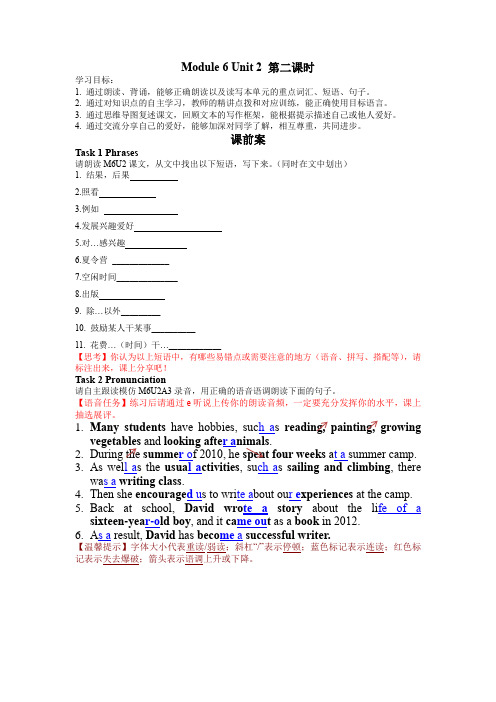
Module 6 Unit 2 第二课时学习目标:1. 通过朗读、背诵,能够正确朗读以及读写本单元的重点词汇、短语、句子。
2. 通过对知识点的自主学习,教师的精讲点拨和对应训练,能正确使用目标语言。
3. 通过思维导图复述课文,回顾文本的写作框架,能根据提示描述自己或他人爱好。
4. 通过交流分享自己的爱好,能够加深对同学了解,相互尊重,共同进步。
课前案Task 1 Phrases请朗读M6U2课文,从文中找出以下短语,写下来。
(同时在文中划出)1. 结果,后果2.照看3.例如4.发展兴趣爱好5.对…感兴趣6.夏令营_____________7.空闲时间______________8.出版9. 除…以外_________10. 鼓励某人干某事__________11. 花费…(时间)干…____________【思考】你认为以上短语中,有哪些易错点或需要注意的地方(语音、拼写、搭配等),请标注出来,课上分享吧!Task 2 Pronunciation请自主跟读模仿M6U2A3录音,用正确的语音语调朗读下面的句子。
【语音任务】练习后请通过e听说上传你的朗读音频,一定要充分发挥你的水平,课上抽选展评。
1.Many students have hobbies, suc h a s reading, painting, growingvegetables and looking afte r a nimals.2.During the summe r o f 2010, he spent four weeks a t a summer camp.3.As wel l a s the usua l a ctivities, su ch a s sailing and climbing, therewa s a writing class.4.Then she encourage d u s to wri te a bout ou r e xperiences at the camp.5.Back at school, David wro te a story about the li fe of asixteen-yea r-o ld boy, and it ca me ou t as a book in 2012.6.A s a result, David has beco me a successful writer.【温馨提示】字体大小代表重读/弱读;斜杠“/”表示停顿;蓝色标记表示连读;红色标记表示失去爆破;箭头表示语调上升或下降。
外研版八年级英语上Module 6 Unit 2教案与反思
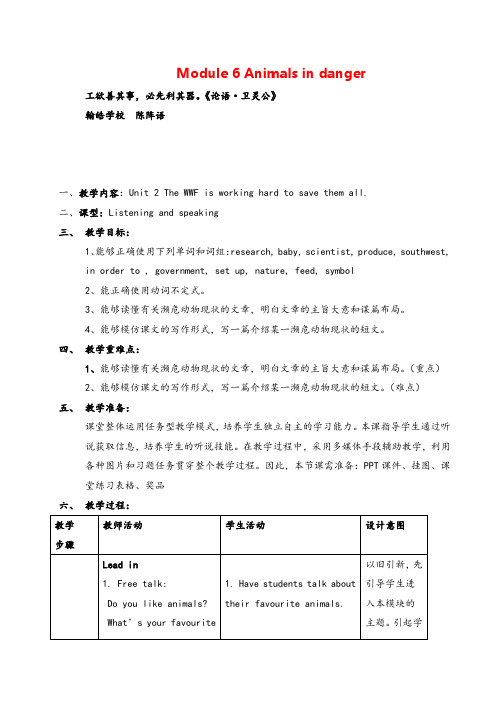
Module 6 Animals in danger工欲善其事,必先利其器。
《论语·卫灵公》翰皓学校陈阵语一、教学内容:Unit 2 The WWF is working hard to save them all.二、课型:Listening and speaking三、教学目标:1、能够正确使用下列单词和词组:research, baby, scientist, produce, southwest,in order to , government, set up, nature, feed, symbol2、能正确使用动词不定式。
3、能够读懂有关濒危动物现状的文章,明白文章的主旨大意和谋篇布局。
4、能够模仿课文的写作形式,写一篇介绍某一濒危动物现状的短文。
四、教学重难点:1、能够读懂有关濒危动物现状的文章,明白文章的主旨大意和谋篇布局。
(重点)2、能够模仿课文的写作形式,写一篇介绍某一濒危动物现状的短文。
(难点)五、教学准备:课堂整体运用任务型教学模式,培养学生独立自主的学习能力。
本课指导学生通过听说获取信息,培养学生的听说技能。
在教学过程中,采用多媒体手段辅助教学,利用各种图片和习题任务贯穿整个教学过程。
因此,本节课需准备:PPT课件、挂图、课堂练习表格、奖品六、教学过程:七、板书设计:Module 6 Animals in danger.Unit 2 The WWF is working hard to save them all.in the wild have many babiesin order to… set up = buildnature park feed the pandasdo a lot of research in order to…set up = build nature parkfeed the pandas达标训练题一.完成下列句子:1、为了保护大熊猫,政府正在建立自然公园。
Module6Unit2说课课件-外研版八年级上册英语
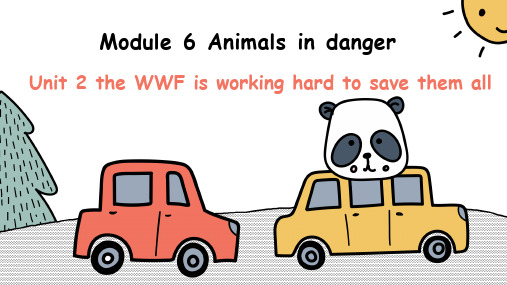
Master infinitive sentence pattern: to do .作目的状语和 宾语补足语
Part 2 Teaching points and methods
Teaching Methods
Task-based Language Teaching method (TBLT)
Pre-reading, While-reading, Post-reading method (PWP)
3 Teaching procedures
Pre-reading
Step1 Warming up
At the very beginning of this class, Miss Liu will show students a video about pandas, so as to lead into the topic—The WWF is working hard to save them all.
感 Thanks for 谢 your listening !
Step5. Homework
Retell the main things with your partner about the passage and try to recite it. Choose an animals in danger and try to finish a writing base on the page’s activity 5.
2 Teaching Procedures Teaching points and methods
Important Points
Difficult Points
1. Master these new words and expressions.
外研版Module 6 Animals in danger Unit 2 The WWF is working hard to save them all.
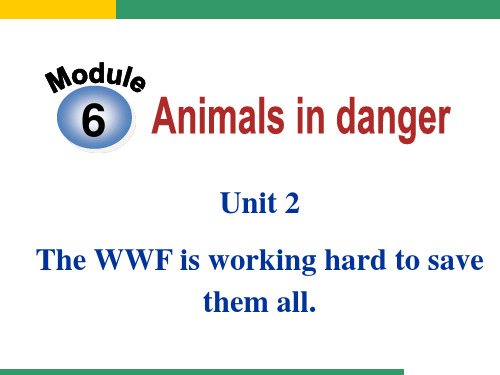
and baby pandas often die. The situation is
getting very difficult. Scientists are doing a
lot of research to help pandas produce more
babies and help baby pandas live.
1__________ d
Pandas are in danger. There are only about
1,600 pandas in the wild today. Zoos and
research centers are looking after about 340
pandas. Pandas do not have many babies,
3. How is the government trying to save the panda? The government has made a new plan to help pandas. They are making bigger reserves and helping pandas go back to live in the nature. 4. Why do you think there is a long way to go to help the panda? Because pandas don’t have many babies and baby pandas often die, etc.
the pandas. Pandas born in zoos may go back to
live in the nature parks.
Module6Unit2教案-外研版九年级上册英语

此外,在新课讲授过程中,我发现学生们对西方音乐文化背景知识的了解相对匮乏。为了拓宽他们的视野,我计划在后续的教学中引入更多关于音乐家及其作品的背景介绍,使学生们在欣赏音乐的同时,也能了解到背后的历史和文化。
3.成果分享:每个小组将选择一名代表来分享他们的讨论成果。这些成果将被记录在黑板上或投影仪上,以便全班都能看到。
(五)总结回顾(用时5分钟)
今天的学习,我们了解了西方音乐的基本类型、特点及其在日常生活中的应用。同时,我们也通过实践活动和小组讨论加深了对西方音乐的理解。我希望大家能够掌握这些知识点,并在日常生活中学会欣赏和运用西方音乐。最后,如果有任何疑问或不明白的地方,请随时向我提问。
(3)对一般现在时和一般过去时的运用,尤其是在描述音乐作品和音乐家时;
举例:学生可能在描述过去事件时混淆时态,如将“Beethoven composed his Ninth Symphony”误用为“Beethoven composes his Ninth Symphony.”
(4)听力训练中,对西方音乐作品和音乐家的识别与理解;
1.提高学生的英语语言能力,使他们能够理解并运用音乐相关词汇和表达,描述不同类型的西方音乐特点;
2.培养学生的文化意识,通过了解西方音乐的历史和背景,增强对多元文化的尊重和理解;
3.发展学生的思维品质,通过分析音乐作品,培养批判性思维和审美鉴赏能力;
4.提升学生的学习能力,使学生掌握有效的学
五、教学反思
在Module 6 Unit 2《Western music》的教学过程中,我发现学生们对西方音乐表现出了浓厚的兴趣。他们在课堂上积极参与讨论,认真聆听音乐作品,这让我感到很欣慰。然而,通过这次教学,我也意识到一些需要改进的地方。
外研版英语八年级上册Module 6《Animals in danger》(Unit 3)教学设计
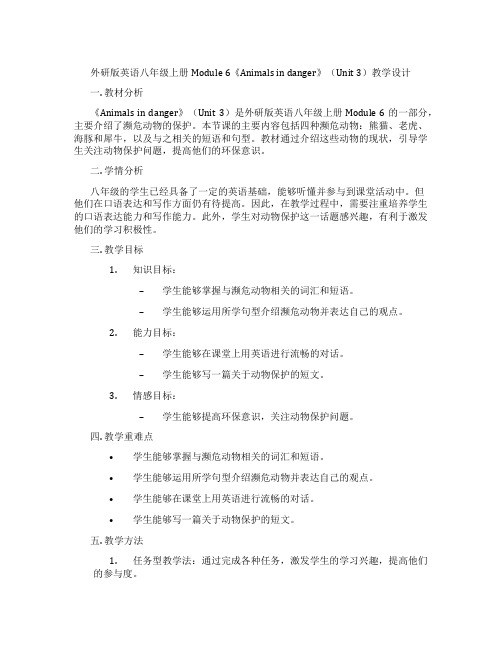
外研版英语八年级上册Module 6《Animals in danger》(Unit 3)教学设计一. 教材分析《Animals in danger》(Unit 3)是外研版英语八年级上册Module 6的一部分,主要介绍了濒危动物的保护。
本节课的主要内容包括四种濒危动物:熊猫、老虎、海豚和犀牛,以及与之相关的短语和句型。
教材通过介绍这些动物的现状,引导学生关注动物保护问题,提高他们的环保意识。
二. 学情分析八年级的学生已经具备了一定的英语基础,能够听懂并参与到课堂活动中。
但他们在口语表达和写作方面仍有待提高。
因此,在教学过程中,需要注重培养学生的口语表达能力和写作能力。
此外,学生对动物保护这一话题感兴趣,有利于激发他们的学习积极性。
三. 教学目标1.知识目标:–学生能够掌握与濒危动物相关的词汇和短语。
–学生能够运用所学句型介绍濒危动物并表达自己的观点。
2.能力目标:–学生能够在课堂上用英语进行流畅的对话。
–学生能够写一篇关于动物保护的短文。
3.情感目标:–学生能够提高环保意识,关注动物保护问题。
四. 教学重难点•学生能够掌握与濒危动物相关的词汇和短语。
•学生能够运用所学句型介绍濒危动物并表达自己的观点。
•学生能够在课堂上用英语进行流畅的对话。
•学生能够写一篇关于动物保护的短文。
五. 教学方法1.任务型教学法:通过完成各种任务,激发学生的学习兴趣,提高他们的参与度。
2.情境教学法:创设真实的情境,让学生在实际语境中学习英语。
3.合作学习法:鼓励学生分组合作,培养他们的团队精神。
六. 教学准备1.教师准备:–制作课件和教学素材。
–准备相关的视频和图片。
2.学生准备:–预习教材,了解本节课的主要内容。
–准备相关的词汇和短语。
七. 教学过程1.导入(5分钟)–教师通过展示濒危动物的图片,引导学生关注动物保护问题。
–学生分享他们对濒危动物的了解和观点。
2.呈现(10分钟)–教师通过课件呈现本节课的主要内容,包括词汇、短语和句型。
- 1、下载文档前请自行甄别文档内容的完整性,平台不提供额外的编辑、内容补充、找答案等附加服务。
- 2、"仅部分预览"的文档,不可在线预览部分如存在完整性等问题,可反馈申请退款(可完整预览的文档不适用该条件!)。
- 3、如文档侵犯您的权益,请联系客服反馈,我们会尽快为您处理(人工客服工作时间:9:00-18:30)。
Module 6 Animals in danger
【教材分析】
本模块以“Animals in danger”为话题,以学习动词不定式的用法为主线,介绍了当前濒临灭绝,需要人类保护的动物的情况,并重点介绍了大熊猫的保护情况。
在此基础上,学生可以根据自己的建议制定更合理的动物保护措施。
Unit 2 The WWF is working hard to save them all.
【教学目标】
Knowledge objective
Key vocabulary—research, baby, situation, scientist, produce, feed,government, nature, develop, symbol
Key structures—nature park
Moral objective
1.Tohelpstudentsknowtheimportanceofprotectinganimalsandourenvironment.
2. Improve their sense of duty to love and protect animals.
【教学重点】
1. To get information from the reading material about pandas.
2. To learn some new words.
【教学难点】
To understand the main idea of each paragraph of the article.
【教学方法】
PWP method, task-based method
【教学手段】
A tape recorder, multimedia and some pictures
【教学过程】
Teaching Procedures:
Step 1 Lead-in
1.Look at the pictures and guess what the animal is.
2.Look at the pictures and answer the questions about the panda.Step 2 Consolidate new words
Lookandsay.Theteachersshowsthepicturesofnewwordsandletthestudents to say as quickly as possible.
Step 3 Say what you know about pandas
Work in pairs. Look at the pictures and say something about pandas.Step 4 Listen and answer the questions
1.How many pandas are there in the wild today?
2.What’s the symbol ofthe WWF?
Step 5 Read the passage and match the headings with the paragraphs
Read the passage and match the headings with the paragraphs.
Step 6 Read the passage and answer the questions
1. What are scientists studying?
2. Are there many of pandas left?
3. What is the government doing to protect pandas in the wild?
4. Is the panda the symbol of all animals in danger?
Step 7 Read the passage and complete the sentences
1.Scientistsdoalotofresearch_______________________________________.
2. The government is setting up nature parks ____________________.
3. The WWF chose the panda _________________.
4. The WWF is working hard __________________.
Step 8 Complete the sentences with the words in the box
Readthepassagecarefullyandgetthemainideaandchoosethewordsfrom the box, then use the correct form to fill in the blanks.
Step 9 Language points
1. Scientists are doing a lot of research to help pandas produce more babies…
do a lot of research表示“做大量研究”。
research是不可数名词。
produce表示“生育,繁殖”。
e.g. produce more babies
2. Each pandas needs to eat a lot of bamboo every day.
every和each的区别。
•every “每”“各”,指三者或三者以上的整体,含有全体之意。
e.g. Every boy is here.所有男孩都在这儿。
•each “每一”“每个”,指两个或两个以上的每一个,着重于个别,如团体中一个的人或物。
e.g. He spoke to each member of the team.
他和队里的每个队员都说了话。
3.Inordertoprotectpandasinthewild,thegovernmentissettingupnatureparks …
•set up创建,创办
e.g. He wants to set up a school for the poor children.他想为贫困地区的孩子创办一所学校。
•In order (not) to do sth.为了(不)做……
e.g. In order to be a doctor, you have to study for five years in a college.要当一名医生,你需要在大学学习五年。
They need to raise 5,000,000 US dollars in order to pay for the repairs.为了支付修理费用,他们需要筹集500万美元。
Step 10 Choose an animals in danger and answer the questions
1. What is the animal?
2. Where does it live?
3. What does it feed on?
4. Why is it in danger?
5. How difficult is the situation?
6. How could we save it?
eyouranswersinActivity 5 and the following example to help you
Pandas live the southwest of China. They are in danger and the situation isgettingverydifficult.First,pandasdon’thavemanybabiesandbabypandasoften die. Second, pandas eat bamboo and the bamboo forests are getting smaller.But the government is creating nature parks with a lot of bamboo to help protectpandas.
Step 12 Summary
Let Ss talk about what they have learnt in class.
Step 13 Exercises
Let the students practice the main points in Unit 2.
Step 14中考链接
Do some exercises from the entrance exam to senior high schools.Step 15 Homework
Make a poster about protecting animals in danger.
【课后反思】。
